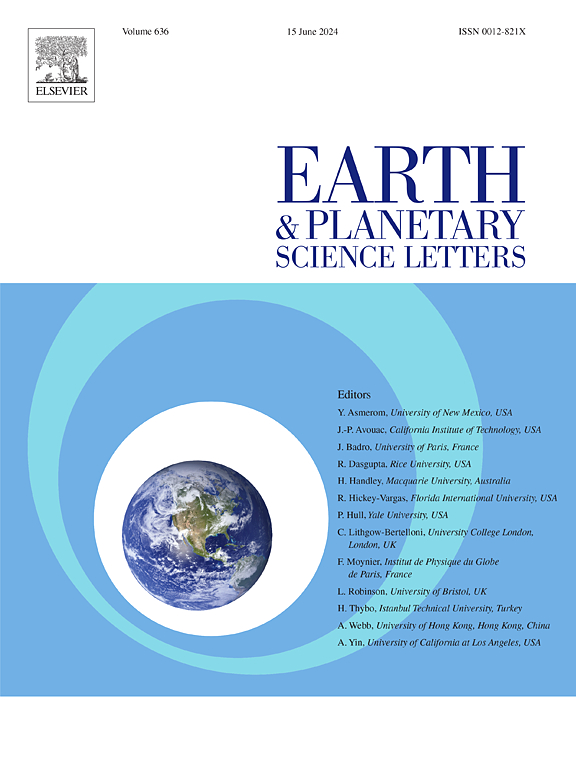The extraterrestrial dust accretion rate on Earth at Dome C, Antarctica: a fresh look with 3He
IF 4.8
1区 地球科学
Q1 GEOCHEMISTRY & GEOPHYSICS
引用次数: 0
Abstract
Interplanetary dust particles (IDPs) and micrometeorites (MMs), from 1 µm to 5 mm, are the primary source of extraterrestrial (ET) material currently accreted on Earth. The flux of ET particles smaller than ∼50 µm is typically determined through optical counting, but it remains uncertain and may deviate from predictions made by numerical simulations. The volatile element content carried by this flux is still not well-constrained and is influenced by the potential effects of atmospheric heating.
We developed a clean, pressurized system to extract cosmic dust from ∼38 kg of clean snow collected near the Concordia station (Dome C, Antarctica). We measured helium isotope concentrations in various granulometric fractions (> 62 µm, 25–62 µm, 5–25 µm and < 5 µm). The inferred global 3HeET annual flux is (1.25±0.03) × 10⁻¹² ccSTP·cm⁻²·ka⁻¹ (weighted mean±1SD), consistent with previous 3HeET flux estimates from marine sediments and polar samples. Our data shows that the majority of the 3HeET flux (70 %) is carried by particles in the 5–25 µm size range, with 20 % attributed to the 25–62 µm fraction. Using an empirical relationship between 3HeET concentrations and cosmic particle mass, we convert these fluxes into a global ET mass flux for particle diameters < 100 µm of (3.5±0.5) kilotons·a⁻¹ (weighted mean±1SD). This result is about 3 times higher than collection estimates from (Rojas et al., 2021) and aligns with CABMOD-ZoDy modeling, after atmospheric entry (Carrillo-Sánchez et al., 2020). This 3HeET method is suited for detecting particles smaller than 100 µm, while collection results are more relevant for larger fractions.
地球上的外星尘埃增加率在圆顶C,南极洲:一个新的面貌与3He
星际尘埃颗粒(IDPs)和微陨石(mm),直径从1µm到5 mm,是目前地球上吸积的地外物质的主要来源。小于~ 50µm的ET粒子的通量通常是通过光学计数来确定的,但它仍然是不确定的,并且可能与数值模拟的预测相偏离。该通量所携带的挥发性元素含量仍未得到很好的约束,并受到大气加热的潜在影响。我们开发了一种清洁的加压系统,从Concordia站(Dome C, Antarctica)附近收集的约38公斤清洁雪中提取宇宙尘埃。我们测量了不同颗粒馏分中的氦同位素浓度(>;62µm, 25-62µm, 5-25µm和<;5µm)。推断出的全球3HeET年通量为(1.25±0.03)× 10⁻¹²ccSTP·cm⁻²·ka⁻¹(加权平均值±1SD),与之前从海洋沉积物和极地样本中估计的3HeET年通量一致。我们的数据表明,大部分的3HeET通量(70%)是由5-25µm粒径范围内的颗粒携带的,其中20%归因于25-62µm的部分。利用3HeET浓度与宇宙粒子质量之间的经验关系,我们将这些通量转换为粒子直径<的全球ET质量通量;100µm(3.5±0.5)千吨·a⁻¹(加权平均值±1SD)。这一结果比(Rojas et al., 2021)的收集估算值高出约3倍,并与进入大气后的CABMOD-ZoDy模型一致(Carrillo-Sánchez et al., 2020)。这种3HeET方法适用于检测小于100 μ m的颗粒,而收集结果更适用于较大的分数。
本文章由计算机程序翻译,如有差异,请以英文原文为准。
求助全文
约1分钟内获得全文
求助全文
来源期刊

Earth and Planetary Science Letters
地学-地球化学与地球物理
CiteScore
10.30
自引率
5.70%
发文量
475
审稿时长
2.8 months
期刊介绍:
Earth and Planetary Science Letters (EPSL) is a leading journal for researchers across the entire Earth and planetary sciences community. It publishes concise, exciting, high-impact articles ("Letters") of broad interest. Its focus is on physical and chemical processes, the evolution and general properties of the Earth and planets - from their deep interiors to their atmospheres. EPSL also includes a Frontiers section, featuring invited high-profile synthesis articles by leading experts on timely topics to bring cutting-edge research to the wider community.
 求助内容:
求助内容: 应助结果提醒方式:
应助结果提醒方式:


